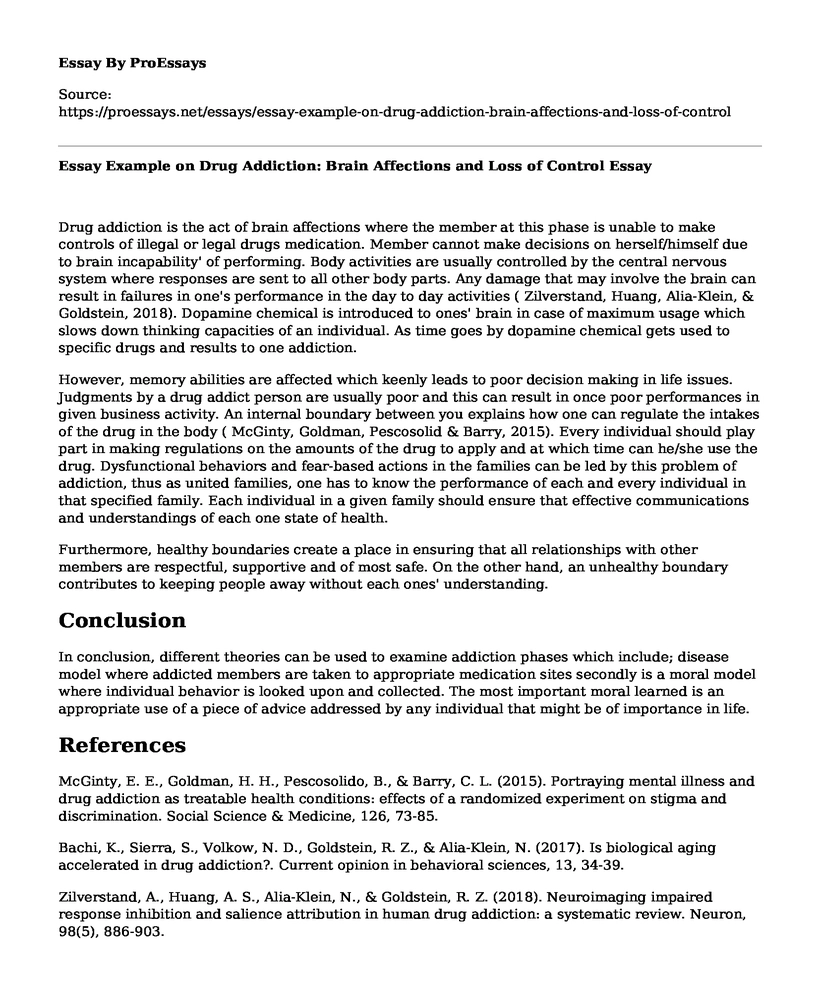Drug addiction is the act of brain affections where the member at this phase is unable to make controls of illegal or legal drugs medication. Member cannot make decisions on herself/himself due to brain incapability' of performing. Body activities are usually controlled by the central nervous system where responses are sent to all other body parts. Any damage that may involve the brain can result in failures in one's performance in the day to day activities ( Zilverstand, Huang, Alia-Klein, & Goldstein, 2018). Dopamine chemical is introduced to ones' brain in case of maximum usage which slows down thinking capacities of an individual. As time goes by dopamine chemical gets used to specific drugs and results to one addiction.
However, memory abilities are affected which keenly leads to poor decision making in life issues. Judgments by a drug addict person are usually poor and this can result in once poor performances in given business activity. An internal boundary between you explains how one can regulate the intakes of the drug in the body ( McGinty, Goldman, Pescosolid & Barry, 2015). Every individual should play part in making regulations on the amounts of the drug to apply and at which time can he/she use the drug. Dysfunctional behaviors and fear-based actions in the families can be led by this problem of addiction, thus as united families, one has to know the performance of each and every individual in that specified family. Each individual in a given family should ensure that effective communications and understandings of each one state of health.
Furthermore, healthy boundaries create a place in ensuring that all relationships with other members are respectful, supportive and of most safe. On the other hand, an unhealthy boundary contributes to keeping people away without each ones' understanding.
Conclusion
In conclusion, different theories can be used to examine addiction phases which include; disease model where addicted members are taken to appropriate medication sites secondly is a moral model where individual behavior is looked upon and collected. The most important moral learned is an appropriate use of a piece of advice addressed by any individual that might be of importance in life.
References
McGinty, E. E., Goldman, H. H., Pescosolido, B., & Barry, C. L. (2015). Portraying mental illness and drug addiction as treatable health conditions: effects of a randomized experiment on stigma and discrimination. Social Science & Medicine, 126, 73-85.
Bachi, K., Sierra, S., Volkow, N. D., Goldstein, R. Z., & Alia-Klein, N. (2017). Is biological aging accelerated in drug addiction?. Current opinion in behavioral sciences, 13, 34-39.
Zilverstand, A., Huang, A. S., Alia-Klein, N., & Goldstein, R. Z. (2018). Neuroimaging impaired response inhibition and salience attribution in human drug addiction: a systematic review. Neuron, 98(5), 886-903.
Cite this page
Essay Example on Drug Addiction: Brain Affections and Loss of Control. (2023, Jan 02). Retrieved from https://proessays.net/essays/essay-example-on-drug-addiction-brain-affections-and-loss-of-control
If you are the original author of this essay and no longer wish to have it published on the ProEssays website, please click below to request its removal:
- Health Care and Hispanic Families Paper Example
- Premarital Screening Test for Sickle Cell in Saudi Arabia - Essay Sample
- Essay Sample on Trends in Tobacco Use
- Essay Example on 1960s Health Care Reform: The Birth of Medicare & Medicaid
- Essay Sample on Sadiqa Khan's Journey to Understand Race & White Privilege
- Online Therapy: A Growing Form of Telehealth - Essay Sample
- Report Sample on the U.S. Healthcare System: A Complex Network of Providers and Regulators







